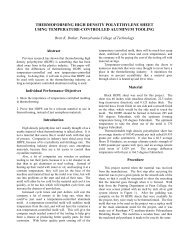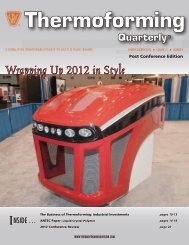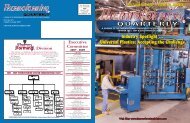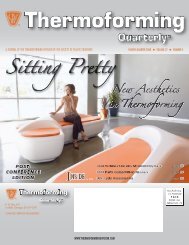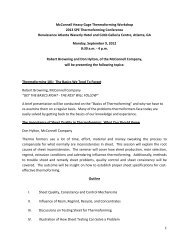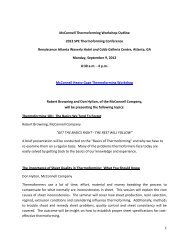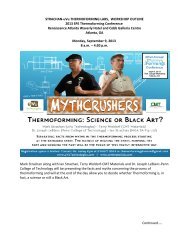Third Quarter - SPE Thermoforming Division
Third Quarter - SPE Thermoforming Division
Third Quarter - SPE Thermoforming Division
Create successful ePaper yourself
Turn your PDF publications into a flip-book with our unique Google optimized e-Paper software.
<strong>Thermoforming</strong><br />
<strong>Quarter</strong>ly ®<br />
The Business of <strong>Thermoforming</strong><br />
<strong>Thermoforming</strong> Optimization: Improving Process<br />
Efficiency and Lowering Energy Consumption<br />
William Karszes, PhD, OCTAL, Roswell, GA<br />
Mohammed Razeem, OCTAL, Dallas, TX<br />
Jerome Romkey, GN, Chester, Novia Scotia<br />
[Editor’s Note: We are grateful to the authors for providing such a comprehensive<br />
article that includes cost and energy savings models. We believe it is important<br />
to point out that the models and subsequent data are presented in <strong>Thermoforming</strong><br />
QuarTerly as illustrative examples of how processors might examine their own<br />
operational performance. Equipment type and processing parameters will vary across<br />
the industry.]<br />
SUMMARY<br />
This paper was written to explore<br />
the effects of material and machine<br />
choice on the thermoforming process.<br />
The data and findings related to<br />
production costs, energy consumption<br />
and process optimization. Within this<br />
paper we explore two different types<br />
of machines. One is distinguished<br />
by the heating of the plastic by<br />
conduction of heat into the plastic<br />
from a heated platen. This process<br />
is defined as contact heat method<br />
(GN-DX series). The second process<br />
is where the heat is introduced into<br />
the sheet by electromagnetic waves<br />
or radiant heat called the radiant heat<br />
method. The source of the radiant heat<br />
may be varied and the control scheme<br />
is varied between the two processes.<br />
GN machines are based on the contact<br />
heat method. This paper will not<br />
go into the technical details of each<br />
process, but is written to compare the<br />
economics of the two processes. Also<br />
within this study we examine the<br />
effects of a specific material DPET<br />
(OCTAL) on the economics of the<br />
process.<br />
INTRODUCTION<br />
A new-patented process has been<br />
developed by OCTAL Petrochemical<br />
to produce APET sheet. The new<br />
process has been created to produce<br />
a new sheet specifically for the<br />
thermoformer. The new product trade<br />
named DPET was tested in GN<br />
laboratories in Chester, Nova Scotia.<br />
The material was tested against RPET<br />
and regular APET. The purpose of<br />
the tests was to develop a cycle that<br />
produced a well-formed part of like<br />
clarity. During experiments a new<br />
GN machine was also tested (GN’s<br />
DX series). The test results showed<br />
DPET had a faster cycle time, was<br />
more efficient and could be run with<br />
lower clamping pressure.<br />
OCTAL and GN have developed<br />
costing models for thermoformed trays.<br />
The two models are presented and<br />
compared. The models are then used<br />
to show savings to the thermoformer<br />
when using DPET and GN machines.<br />
It is important to note that the material<br />
thickness and part design chosen for<br />
this study reflect a process that did not<br />
require a plug-assist.<br />
Based on the costing models up to<br />
24% bottom line savings can be added<br />
to thermoformers using the new DX<br />
machine and DPET. The cost models<br />
allow the processor to explore their<br />
own possible saving. Both models lead<br />
to the same answers. The GN model<br />
allows one to investigate processing<br />
cost, investment cost and return on<br />
investment. The most important finding<br />
of the model is that 50% less waste on<br />
GN thermoformer can lower customer<br />
total production cost by approximate<br />
12%. The study shows that investment<br />
costs plus return on investment is<br />
important but not so much as the waste.<br />
The OCTAL model treats only the<br />
processing cost.<br />
Furthermore, thermoformers’ customers<br />
are demanding cost containment<br />
while requiring more environmentally<br />
friendly products. Thermoformers need<br />
to have new innovative technologies not<br />
only to contain cost but also to reduce<br />
their carbon footprint as legislature<br />
points to tougher standards. OCTAL<br />
commissioned PIRA (Printing Industry<br />
Research Association) to conduct a<br />
streamlined comparison of carbon<br />
footprint of DPET against APET<br />
and RPET. The results of the study are<br />
shown in Table 1 below.<br />
MATERIAL CARBON DIOXIDE EQUIVALENCE<br />
APET<br />
4.173 Kg<br />
DPET<br />
3.023 Kg<br />
RPET<br />
3.015 Kg<br />
Table 1. Carbon Footprint.<br />
As per study conducted by PIRA for OCTAL;<br />
DPET TM has a carbon footprint 27.6% lower<br />
than APET and only 0.2% higher than 50%<br />
RPET.<br />
When compared to APET and RPET,<br />
DPET has a carbon footprint 27.6%<br />
lower than APET and only 0.2% higher<br />
than 50% RPET (50% RPET+50%<br />
APET) assuming that no energy is<br />
carried on from the post consumer<br />
waste.<br />
EXPERIMENTAL<br />
PROCEDURE<br />
Rolls of APET, RPET and DPET<br />
were tested in the GN laboratory.<br />
All materials were 16 mil (or 400<br />
microns) (nominal). The material was<br />
formed into trays with a four to one<br />
14 <strong>Thermoforming</strong> QUArTerLY



